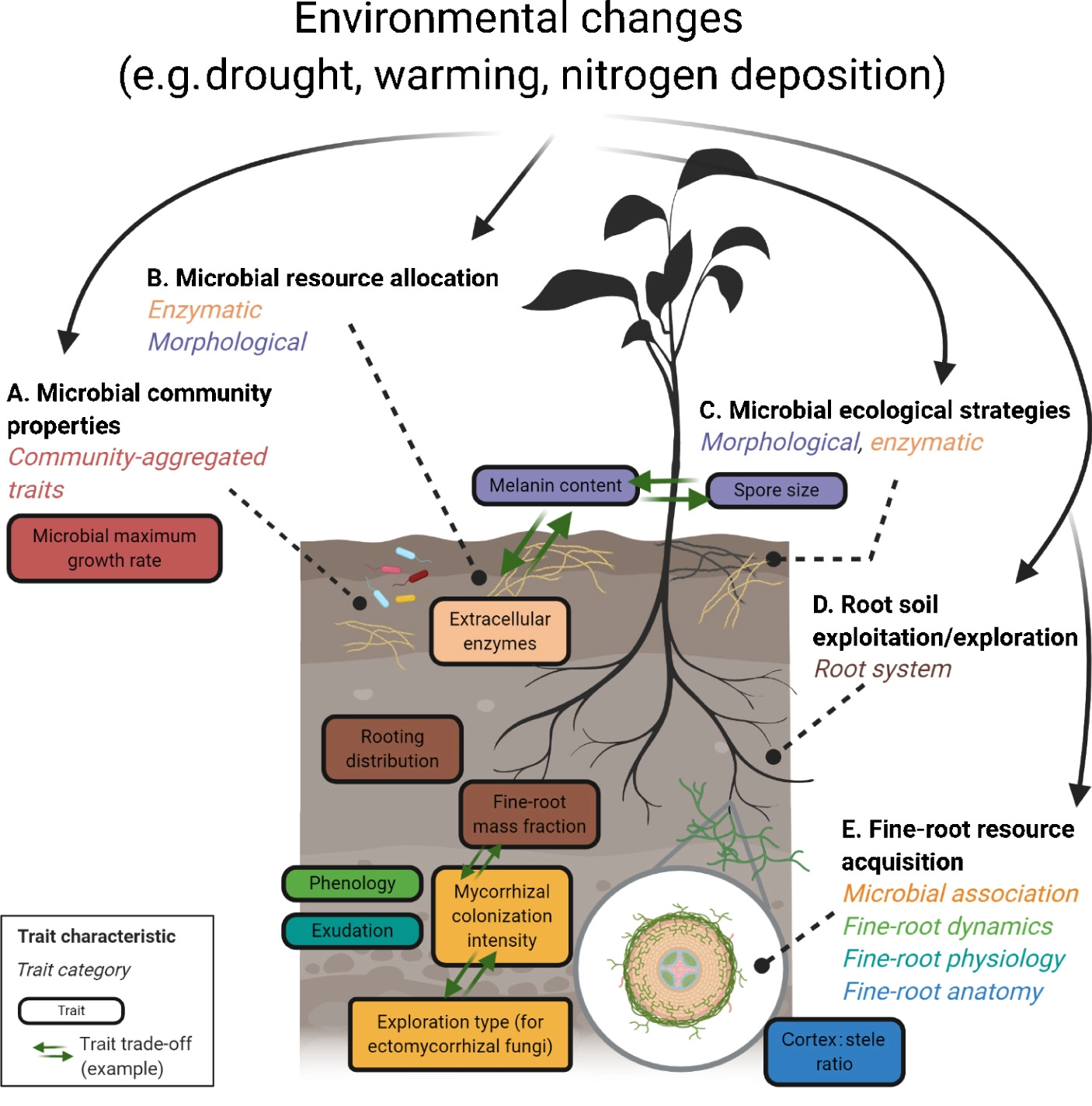February 17, 2021
Building a Collaborative Future of Belowground Ecology and Ecologists
Ecology Underground: A two-day program of live virtual talks and open discussions on integrative belowground ecology

Diagram of key functional traits and trait trade-offs of free-living soil microbes, fine roots, and mycorrhizal fungi discussed at Ecology Underground. These traits hold promise for assessing and modeling the responses of belowground processes to changing environments.
[Reprinted under a Creative Commons Attribution 4.0 International License (CC BY 4.0) from Defrenne, C.E., et al. “The Ecology Underground Coalition: Building an Integrative Future of Belowground Ecology and Belowground Ecologists.” New Phytologist 229(6), 3058–3064 (2021). DOI: 10.1111/nph.17163]
The Science
Through two days of online synchronous presentations and discussion, Ecology Underground highlighted three research frontiers in belowground ecology: (1) the power of trait-based approaches for linking plants, microbes, and ecosystem processes; (2) the identification of relevant spatial and temporal scales for studies in belowground ecology; and (3) the development of models that connect microscale dynamics to predict belowground processes globally.
The Impact
The Ecology Underground group discussed the next steps in assessing and modeling the responses of belowground processes to changing environments, paving the way for next-generation research on belowground ecology.
Summary
The 2020 pandemic allowed the Ecological Society of America (ESA) to enter a new digital era by holding a fully virtual conference. Early-career plant and microbial ecologists from six ESA Organized Sessions took this opportunity to organize Ecology Underground, a two-day program of live virtual talks and open discussions on integrative belowground ecology. The discussions at Ecology Underground shaped the future directions in belowground ecology. First, trait-based approaches showed promise for linking plants, microbes, and ecosystem processes. For example, functional traits that underpin ecological strategies may help to assess and model response of free-living microbes to changing environments. Second, a better understanding of the spatial and temporal consistency and turnover in microbial communities and fine-root dynamics was critical to the integration of belowground processes into Earth System Models and ecological forecasts. Third, the use of models that represent multiple scales was key to bridge the gap between soil ecological observations at locations across the globe and biosphere model predictions. Lastly, the group that participated in Ecology Underground stressed that heading in these directions will require strong global networks, cross-disciplinary collaboration, and a diversity of perspectives only achievable through a diverse community of ecologists. Creating such a community will require organizations to recruit, support, and promote Black, Indigenous, People of Color, and other historically excluded people in science.
Principal Investigator
Camille E. Defrenne
Oak Ridge National Laboratory
[email protected]
Program Manager
Daniel Stover
U.S. Department of Energy, Biological and Environmental Research (SC-33)
Environmental System Science
[email protected]
Funding
Sponsors: New Phytologist, the Office of Biological and Environmental Research (BER) within the U.S. Department of Energy (DOE) Office of Science, the Oak Ridge Institute for Science and Education, and the Ecological Society of America’s Soil Ecology Section.
- The following authors were supported by the DOE Office of Science: Camille Defrenne (BER); Elsa Abs (BER, DE-SC0020382); Amanda Longhi Cordeiro, Lee Dietterich, and Daniela Cusack (Early Career Research Program, DE-SC0015898); and Daniel Stover.
- The following authors were supported by the National Science Foundation: Moira Hough (2022070 for the EMERGE Biology Integration Institute), Jennifer M. Jones (LTER, DEB 1832042), Stephanie N. Kivlin (DEB 1936195), André L.C. Franco (DEB-145663 and OPP-1341648), and Albina Khasanova (Plant Genome Research Program, IOS-1444533).
- Weile Chen was supported by the Zhejiang Provincial Funds for Distinguished Young Scientists (LR21C030002).
Adriana L. Romero-Olivares was supported by the USDA National Institute of Food and Agriculture through the New Hampshire Agricultural Experiment Station Hatch 1016142 and the Diversity & Innovation Scholars Program at the University of New Hampshire.
References
Defrenne, C.E., et al. "The Ecology Underground Coalition: Building an Integrative Future of Belowground Ecology and Belowground Ecologists." New Phytologist 229 (6), 3058–3064 (2021). https://doi.org/10.1111/nph.17163.

